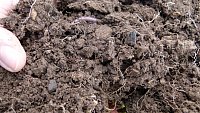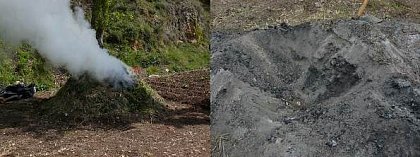‘Formiguer Soils’ – The Mediterranean analogue to terra preta de Indio in the humid tropics?
- Projektförderer: DFG - Deutsche Forschungsgemeinschaft
- Projektleiter: Dr. Katja Wiedner
- Mitarbeiter: Steven Polifka
- Mitverantwortlicher: Prof. Dr. Bruno Glaser
Kooperationspartner:
- Prof. Rosa M. Poch (Universitat de Lleida, Departament de Medi Ambient i Ciències del Sòl, Catalonia)
- Dr. José Olarieta (Universitat de Lleida, Departament de Medi Ambient i Ciències del Sòl, Catalonia)
- Prof. Robert Mikutta (Universität Halle-Wittenberg, Bodenkunde und Bodenschutz)

Photo: M. Balhar
Soils strongly modified by human land use are becoming more important in order to response growing global challenges of the 21st century e.g. such as world nutrition, global warming or soil degradation (Global change). Furthermore, soils may store important information about e.g. ancient agricultural practices, vegetation history or fire events. Reading the information stored in soils on a macroscopic, microscopic and molecular scale helps to understand e.g. human history, landscape changes and soil formation.
An interesting example of “positive land use” is the “formiguer” technique, a traditional fertilizing method in the Mediterranean area for soil improvement and soil conditioning. ‘Formiguers’ were made up of piles of dried woody vegetation that were burnt under a soil cover so that a slow and incomplete combustion was produced. Charcoal and ash were distributed on the agricultural fields or field terraces. Little is known about organic matter application e.g. such as organic waste, dung or even human excrements. In contrast to the surrounding soils, formiguer soils still show high faunal activity, a deep brown to black colour and a good soil structure. The formiguer soils can mostly found as terraced fields up to 3 m high. The age of the terraces is as unknown as the time of the beginning of formiguer fertilization.
The anthropogenic impact on soil formation is, with a few exceptions, poorly addressed and thus far from understood. For instance, “terra preta de Índio” in Amazonia (Brazil) - the most intensive examined Anthrosol plays a pioneering role in Anthrosol research. Terra preta has become a model for sustainable land use and numerous greenhouse and field experiments have been conducted aiming at producing comparable soils in all parts of the world. As might be expected, the experiments e.g. regarding nutrient availability, fate of charcoal in soil or yield potential show contradictory results led to controversial debates.
This project aims to gain a deeper understanding e.g. on soil formation processes caused by human action, charcoal ageing and stability processes as well as soil microbial dynamics of this strong anthropogenically influenced soils under Mediterranean climate conditions. We combine soil micromorphology, spectroscopically techniques (SEM-EDS, FTIR, XPS), stable isotope analysis (δ13C, δ15N) and biomarker analysis (D5-sterols and bile acids, black carbon, PLFA and amino sugars) at different formiguer sites in Catalonia. We work at the interface between geoarchaeology, soil science and agricultural science and the project will provide important results for these and related disciplines.

Formiguer burning (Photos: R. Olarieta)
